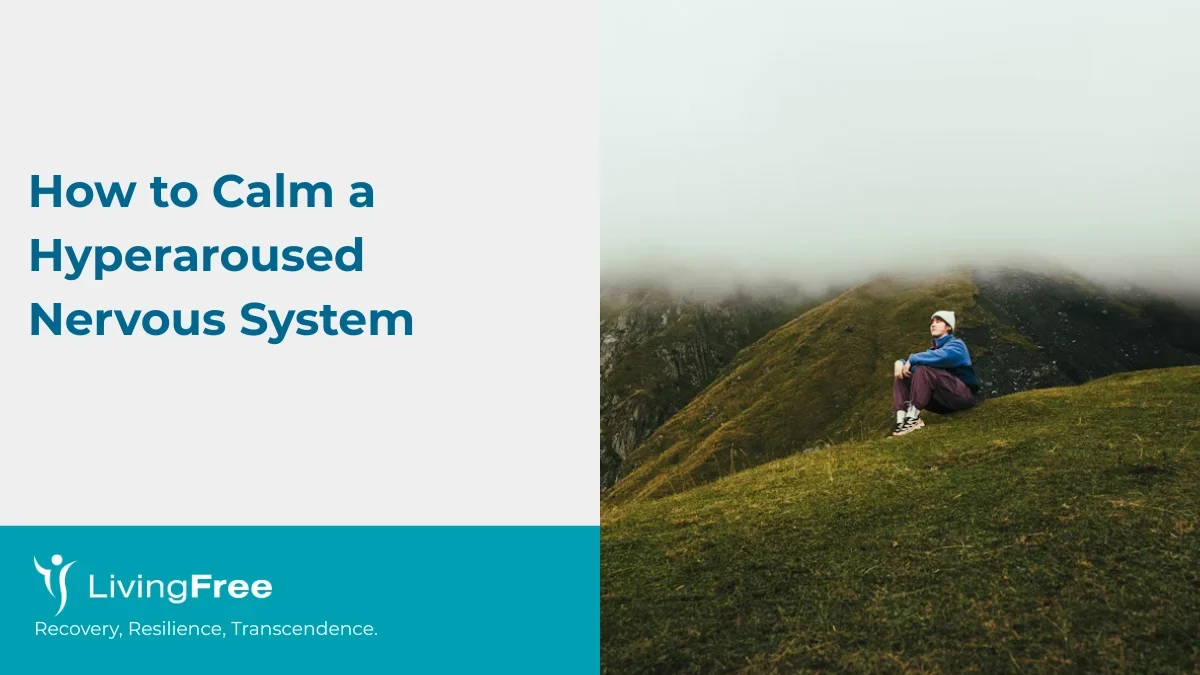To calm a hyperaroused nervous system, focus on grounding techniques like deep breathing and engaging your senses, physical activities such as walking or yoga, and relaxation exercises like meditation or progressive muscle relaxation.
Lifestyle adjustments such as ensuring consistent sleep, avoiding stimulants, and connecting with nature also help regulate your body’s stress response.
Hyperarousal happens when the body’s alarm system stays switched on even without real danger. The heart races, the body tenses, and the mind feels constantly alert.
The goal is not to suppress this reaction, but to gently teach your body that it is safe to rest again.
Understanding the Hyperaroused State
The sympathetic nervous system manages the fight, flight, or freeze response. After trauma or long periods of stress, it can remain overactive, flooding the body with adrenaline and cortisol.
The parasympathetic nervous system restores balance by slowing heart rate and promoting calm. Healing involves strengthening this calming system and retraining the body to move between activation and rest smoothly.
Immediate Calming Techniques
When your body feels tense or your thoughts race, use these grounding methods to regulate the nervous system in the moment.
Deep Breathing
Slowing down your breathing to around five or six breaths per minute can activate the body’s natural relaxation response.
Try the 4-7-8 technique: inhale for four seconds, hold for seven, and exhale for eight. Another option is the physiological sigh, which involves two short inhales followed by a long exhale.
These methods engage the vagus nerve, helping to calm the heart and quiet anxious thoughts.
Engage Your Senses
Grounding through the senses pulls attention away from racing thoughts and back into the present moment.
Try the five-step grounding exercise:
- Name five things you can see
- Four you can touch
- Three you can hear
- Two you can smell
- One you can taste
This gentle sensory focus helps the brain recognize that you are safe right now.
Progressive Muscle Relaxation
Stress often hides in the body as tightness or tension.
To release it, focus on one muscle group at a time. Tense for a few seconds, then release completely. Begin with your feet and move up toward your shoulders and face.
This process helps the body discharge physical energy and reintroduces the sensation of calm.
Grounding and Self-Soothing
Comfort the body with simple sensory support.
Wrap yourself in a weighted blanket, take a warm bath, or hold a comforting object. Physical warmth and touch tell the body that it is supported and safe.
If helpful, add gentle movement or calming sounds to enhance this soothing effect.
Vocalizing
Humming, singing, or gargling can activate the vagus nerve, which connects the brain to the heart and gut.
Vocal vibrations stimulate the parasympathetic system and lower heart rate. You can hum softly, sing a verse, or practice long “mmm” sounds to help the body settle.
Step-by-Step Guide to Calm a Hyperaroused Nervous System
Quick 3-Minute Reset
- Pause and orient
Look around and name five safe objects in sight.
Feel your feet on the floor and take one slow breath. - Physiological sigh × 5
Two short inhales through the nose, one slow exhale through the mouth.
Notice your shoulders drop and tension release. - Cold-warm contrast
Rinse hands with cool water for 10–15 seconds.
Wrap them in a warm towel for 30 seconds to ground your senses.
Immediate Calming, Step by Step
- Breath pacing (2–4 minutes)
Breathe at five to six breaths per minute using 4-7-8 or box breathing (4-4-4-4). - 5-4-3-2-1 senses
Name five things you see, four you touch, three you hear, two you smell, one you taste. - Progressive Muscle Relaxation (3 minutes)
Tense a muscle group for five seconds, release for ten.
Move from feet to face slowly. - Self-soothing input
Use a weighted blanket or hold a warm mug.
Place one hand on your chest, one on your belly, and breathe slowly. - Vocal vagal cue
Hum or sing softly for one minute.
You can also gargle gently for 20–30 seconds. - Gentle movement (2–5 minutes)
Stand and shake out your arms and legs.
Do slow neck rolls and shoulder circles.
Daily Regulation Routine
Morning (5–10 minutes)
- Two minutes of slow breathing.
- Gentle stretching or a short outdoor walk.
Midday (3 minutes)
- Quick sensory grounding using the 5-4-3-2-1 method.
- One minute of humming or slow exhale breathing.
Evening wind-down (15–20 minutes)
- Turn off screens 60 minutes before bed.
- Take a warm shower, do muscle relaxation, then practice 4-7-8 breathing four times.
Lifestyle and Long-Term Strategies
Calming hyperarousal long-term comes from everyday habits that restore the body’s natural rhythm and stability.
Exercise Regularly
Movement helps the body release built-up stress hormones.
Activities like walking, yoga, swimming, or dancing promote a smooth shift between alertness and rest. Choose moderate exercise that leaves you feeling calmer afterward.
Prioritize Sleep
Aim for 7–9 hours of consistent, high-quality sleep.
Go to bed and wake up at the same time each day. Limit caffeine after noon, and make your sleep environment cool, dark, and quiet. Consistent rest restores the brain’s capacity to regulate emotions.
Practice Mindfulness and Meditation
Mindfulness builds awareness of bodily sensations without judgment.
Short daily meditation helps reduce cortisol and stabilize mood. Even five minutes of slow breathing or guided mindfulness can teach the body that calm is safe.
Connect With Nature
Natural environments help down-regulate the nervous system.
Spend a few minutes outside daily, notice sounds, smells, and textures. Sunlight, greenery, and gentle movement outdoors help the body exit the stress cycle.
Limit Stimulants
Reduce caffeine, nicotine, and alcohol, as they can keep the body alert.
Replace coffee with herbal tea or water during the afternoon. Supporting your body with steady hydration and nutrition strengthens your baseline calm.
Create Predictable Routines
Structure reduces the anxiety of uncertainty.
Keep regular times for meals, work, and relaxation. End each evening with a quiet “shutdown” ritual such as stretching or journaling to signal to the body that it can rest.
When to Seek Professional Help
If hyperarousal leads to ongoing insomnia, panic, or impulsive behavior, consider professional support.
Therapies like Somatic Experiencing, EMDR, and Cognitive Behavioral Therapy (CBT) can help process trauma and retrain stress responses.
Medication may also help stabilize severe anxiety or sleep disruption under medical guidance.
Seeking help early prevents chronic exhaustion and supports long-term healing.
The Living Free Perspective
At Living Free, we see hyperarousal as the body’s effort to stay safe, not as a sign of weakness.
Through awareness, gentle self-regulation, and compassionate therapy, the nervous system can rediscover balance and safety.
Each small moment of calm teaches the body that peace is possible again.
Related Reading:
Signs and Symptoms of Hyperarousal You Shouldn’t Ignore
What Causes Hyperarousal? Understanding the Body’s Alarm System


